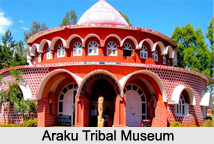 Amar Mahal Museum and Library is located in the Indian state of Jammu and Kashmir. More specifically, this museum is situated in Jammu. Jammu and Kashmir was a former princely state during the British rule in India. It is important to note that the Amar Mahal Palace has been converted into Amar Mahal Museum and Library. Amar Mahal is located on the right bank of the Tawi River. This Mahal was constructed in the nineteenth century by a French architect for Raja Amar Singh, a Dogra king. This palace has a unique, French-chateau style of architecture. Amar Mahal Museum and Library is an ideal place for art lovers, scholars, and historical buffs.
Amar Mahal Museum and Library is located in the Indian state of Jammu and Kashmir. More specifically, this museum is situated in Jammu. Jammu and Kashmir was a former princely state during the British rule in India. It is important to note that the Amar Mahal Palace has been converted into Amar Mahal Museum and Library. Amar Mahal is located on the right bank of the Tawi River. This Mahal was constructed in the nineteenth century by a French architect for Raja Amar Singh, a Dogra king. This palace has a unique, French-chateau style of architecture. Amar Mahal Museum and Library is an ideal place for art lovers, scholars, and historical buffs.
History of Amar Mahal Museum and Library
After the death of Maharani Tara Devi, the wife of the late Maharaja Hari Singh (son of Raja Amar Singh) in the year 1967, Amar Mahal was converted into a museum. This initiative was taken by her son Karan Singh and his wife Yasho Rajya Lakshmi. The aim behind this step was to provide a home to the rare books and works of art. This was thought to yield other benefits. It would provide impetus to the establishment of fine arts centre and lead to the development of artistic talent. It was also thought to stimulate collaboration with other like minded institutions for promotion of Indian arts. According to Karan Singh, the whole effect was to transport one into a fascinating miniature world with its own aura and ethos. To achieve the above mentioned targets, Amar Mahal Palace was converted into a trust called the Hari-Tara Charitable Trust. As a former ruler of Jammu, Karan Singh was initially receiving the Privy Purse from the Government of India. Privy Purse is defined as an allowance voted by the Parliament for the private expenses of a monarch. This Privy Purse was willfully relinquished by Karan Singh. He utilized the funds to make the museum a reality. Thus, Amar Mahal Museum and Library was finally inaugurated on 13th of April, 1975 by the then Prime Minister of India namely, Indira Gandhi.
Galleries and Exhibits of Amar Mahal Museum and Library
Amar Mahal Museum and Library is a home to a variety of objects of great antiquity and rare art collections. The most noteworthy aspect of the museum is the throne weighting near about 120 kg. This throne is made up of pure gold. It is capable of concentrating the eyeballs of a large number of tourists on it. Another noteworthy feature of this palace museum is a suite, the resident of which was Maharani (later recognized as Maharajmata) Tara Devi. It is considered to be an exclusive chamber of the museum. This suite is open for exhibition. It has been noted that tourists are often drawn to this suite having a curiosity to explore it. It is important to note that this suite is still in the same condition as it was when the Maharani used to live here. Some of the authentic ancient items preserved in this suite are the silver bedspread, the period furniture and photographs and the Maharajmata"s personal items of clothing. The unique Victorian bathroom of this suite is also well preserved in the museum. Maharajmata had also received the decoration Crown of India in the year in 1945, which is also an exhibit of this museum.
This museum has art galleries which were created to promote Indian art and artists. More specifically, 4 rooms of the palace have been converted into art galleries, illustrating the royal history of Jammu. These galleries have contemporary art setting and a touch of ethnicity. These galleries have a collection of paintings ranging over different styles. Some of the renowned artists who have created these paintings are M.F. Hussain, J. Swaminathan, G. R. Santosh, Bikash Battacharjee, Ram Kumar and Laxman Pai. More specifically, these galleries are a home to Kangra style of Indian miniature paintings, the Pahari paintings, which illustrates the tales from the Mahabharata and other folklores, especially those of Nal Damyanti. The Dogra-Pahari paintings date back to the second half of the 18th century. The walls of the durbar hall of the palace museum are bedecked with Pahari miniature, Kangra and Basohli miniature paintings. All these paintings are considered to be a visual treat to the tourists.
The library of Amar Mahal Museum is a home to a collection of more than twenty thousand books. It is located in the first and second floors of Amar Mahal Palace. These books are known to have been collected by Dr. Karan Singh over the last fifty years and cover diverse topics like religion, philosophy, political science and fiction. Several bestsellers by international authors are also sheltered in the museum along with the rare volumes from the Library of Raja Amar Singh.
Activities Undertaken in Amar Mahal Museum and Library
The Hari-Tara Charitable Trust is involved in organizing guided tours, book readings, lectures, film shows and hobby classes and other visitor friendly activities in the museum. The trust also actively arranges scholarly exchanges, workshops and exhibitions. Heritage walks around the museum complex are also undertaken with the aim to intimate the visitors with the history of Jammu and surrounding cities in details.
Related Articles
Museums
Museums of Jammu and Kashmir
Indian State Museums
Indian Science Museums













